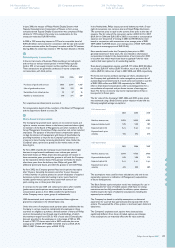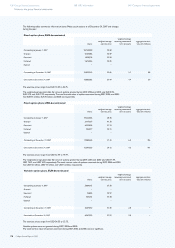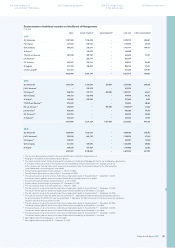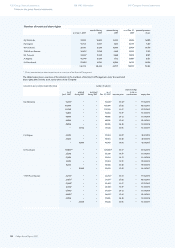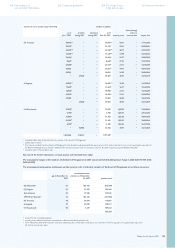Philips 2007 Annual Report Download - page 168
Download and view the complete annual report
Please find page 168 of the 2007 Philips annual report below. You can navigate through the pages in the report by either clicking on the pages listed below, or by using the keyword search tool below to find specific information within the annual report.
Philips Annual Report 2007174
At December 31, 2007, there were 5,084 cases pending, representing
9,906 claimants (compared to 4,370 cases pending, representing 9,020
claimants, at December 31, 2006 and 3,984 cases pending, representing
8,082 claimants, at December 31, 2005). Most of the claims are in cases
involving a number of defendants. During 2007, 1,656 cases, representing
2,413 claimants, were served against the Company’s subsidiaries (1,140
cases, representing 2,930 claimants, were served in 2006 and 2,052
cases, representing 3,283 claimants, were served in 2005). While
management believes there are meritorious defenses to these claims,
certain of these cases were settled by the subsidiaries for amounts
considered reasonable given the facts and circumstances of each case.
A number of other cases have been dismissed with no payment. During
2007, 942 cases, representing 1,527 claimants, were settled or dismissed
(754 cases, representing 1,992 claimants, were settled in 2006 and 977
cases, representing 1,229 claimants, were settled in 2005).
In addition to the pending cases discussed above, a subsidiary of the
Company was one of approximately 160 defendants initially named
in a case led in August 1995 in Morris County, Texas. Since the time
the case was brought in 1995, the subsidiary had not been involved
in any substantive activity in the case other than ling an answer to
the complaint and had no information concerning the types of alleged
diseases or injuries involved. Commencing in the fourth quarter of
2005 and continuing thereafter, plaintiffs’ counsel in this matter led
information concerning the claimants and their alleged diseases with
the Court. The claims have now been severed into ve cases: two cases
with an aggregate of 282 malignant disease claims; two cases with an
aggregate of 223 nonmalignant disease claims with alleged impairment;
and one case with 3,177 claims that have no impairment at this time.
The cases with the malignant disease claims and nonmalignant disease
claims with alleged impairment are currently pending in Morris County.
The case containing the claims that have no impairment at this time
has been transferred to Harris County, Texas.
In accordance with SFAS No. 5, an accrual for loss contingencies is
recorded when it is probable that a liability has been incurred and the
amount of such loss contingency can be reasonably estimated. Prior to
2006, this subsidiary established an accrual for loss contingencies with
respect to asserted claims for asbestos product liability based upon its
recent settlement experience of similar types of claims, taking into
consideration the alleged diseases in pending cases. While it is believed
that this methodology provides a reasonable basis for estimating the
loss where liability is probable, the resolution of each case is based
upon claimant-specic information, much of which is not available until
shortly before the scheduled trial date. For led claims where the
exact type and extent of the alleged illness was not yet known, the
subsidiary established the accrual for loss contingencies based upon
a ‘low end of the range’ estimate using the average settlement experience
for claims alleging only less severe illnesses (i.e. non-malignancy).
An accrual for loss contingencies with respect to unasserted claims
for asbestos product liability was not established prior to 2006 since
the Company, with the assistance of ARPC, a rm with substantial
experience in valuing and forecasting asbestos liabilities, concluded
it could not reasonably estimate this liability in accordance with SFAS
No. 5 due to the subsidiary’s historical claims experience coupled with
the uncertainties surrounding pending and ongoing asbestos litigation
and legislative reform efforts both at the federal and state levels.
During 2006, ARPC reviewed the subsidiary’s history of, among other
things, claims and diseases alleged, and claims settled or dismissed in
order to provide the subsidiary with an estimate of the volume, timing
and cost of both current and future asbestos-related personal injury
claims. In the light of additional claims history experienced by the
subsidiary, as well as the impact of state tort reform in several states,
the clarication of the possibility of national legislation and other factors,
ARPC was able to use a conventional methodology for estimating
future asbestos-related personal injury claims to provide a projection
of the subsidiary’s liability for pending and unasserted potential future
asbestos-related claims for the period from 2006 through 2016 (“the
Study”). As a result of the inherent uncertainties involved in long-term
forecasts, the Company concluded that it did not believe it could
reasonably forecast indemnity costs that might be incurred for claims
asserted after 2016.
The methodology used in the Study to project the subsidiary’s
total liability for pending and unasserted potential future asbestos-
related claims relied upon various assumptions and factors,
including the following:
An analysis of the subsidiary’s pending cases, by type of injury, •
and an allocation of unknown injuries based on the empirical
experience of the subsidiary;
An analysis of data generated from a conventional model used to •
project future asbestos claims for mesothelioma and lung cancer;
An analysis of the correlations between lung cancer ling rates •
and the rates for other cancers and non-malignancy claims;
Epidemiological studies estimating the number of people likely •
to have developed asbestos-related diseases;
An analysis of average claim payment rates and mean payment •
amounts by injury for claims closed in 2005 and 2006;
An analysis of the period over which the subsidiary has resolved •
and is likely to resolve asbestos-related claims against it in the
future; and
An assumed ination rate of 2.5%, reduced by 1.5% to reect •
lower claim valuations due to the aging of the claimant population.
According to the Study, as of September 25, 2006, the estimated cost
of disposing of pending and estimated future claims led through 2016,
excluding future defense and processing costs, totaled USD 507 million
(EUR 396 million). The Study also found that estimates based upon
other calibration metrics, none of which were considered more reliable
than the metrics used, were narrowly grouped within 6 percent in
excess of this projection. Approximately 19 percent of the estimated
liability related to pending claims and approximately 81 percent
related to future claims. As a result, in accordance with SFAS No.5, in
2006 the subsidiary increased its accrual for loss contingencies related
to asbestos product liability to this amount, which represents the
undiscounted estimate of indemnity costs for claims asserted through
2016, without taking account of any potential insurance recoveries.
This resulted in a pre-tax charge to earnings of EUR 334 million for
2006 (a pre-tax charge of EUR 18 million was recorded in 2005).
During 2007, the subsidiary reviewed its accrual for loss contingencies
for asbestos product liability and concluded that the accrual continued
to represent the subsidiary’s liability for pending and estimated future
claims led through 2016 in accordance with SFAS No. 5. At December 31,
2007, the subsidiary’s recorded accruals for loss contingencies for
asbestos product liability amounted to EUR 315.7 million (EUR 378
million at December 31, 2006 and EUR 88 million at December 31,
2005) which is reected in the Company’s consolidated balance sheet.
Projections of future asbestos costs are subject to numerous variables
and uncertainties that are difcult to predict, including the number of
claims that might be received, the type and severity of the disease
alleged by each claimant, future settlement and trial results, future
claim dismissal rates, uncertainties surrounding the litigation process
from jurisdiction to jurisdiction, and the impact of potential changes
in legislative or judicial standards. Accordingly, actual claims asserted
against the Company’s subsidiaries and related settlement amounts
may in fact be lower or higher than the amount currently estimated.
The Company intends to continue to evaluate the subsidiary’s
asbestos-related loss exposure and the adequacy of its reserves in
order to identify trends that may become evident and to assess their
impact on the range of liability that is probable and reasonably estimable.
The estimate of the subsidiary’s liability for pending and unasserted
potential claims does not include future litigation and claim
administration costs. During 2007, the subsidiary incurred asbestos
litigation and claim administration costs totaling EUR 15 million
(EUR 12 million in 2006 and EUR 12 million in 2005).
The subsidiary does not have any signicant assets other than amounts
recoverable under insurance policies that are shared with other
Company subsidiaries. It is not expected that amounts recoverable
under such policies will be sufcient to settle the subsidiary’s liability
for asbestos- related claims. During 2007, the subsidiary and its parent
explored certain steps that may result in a resolution of pending
asbestos claims and claims that may be asserted in the future, including
the possibility of the subsidiary ling for bankruptcy. In this regard,
the subsidiary and its parent have held discussions with several
constituencies regarding the terms of a proposed reorganization
that implements a channeling injunction under section 524 (g) of the
United States federal bankruptcy code. Generally, if such a reorganization
was successful, a Trust would be established to resolve asbestos-
related injury claims brought against the subsidiary, and a channeling
injunction would require that all such claims be presented to the Trust
rather than asserted in the court system. Channeling injunctions under
128 Group nancial statements
Notes to the group nancial statements
188 IFRS information 240 Company nancial statements















